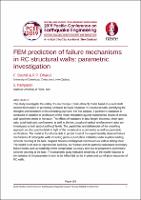FEM prediction of failure mechanisms in RC structural walls: parametric investigation

Download
Date
2019-04-04Authors
Dashti, F.
Dhakal, R. P.
Pampanin, S.
Metadata
Show full item recordAbstract
This study investigates the ability of a microscopic (finite element) model based on curved shell element formulation in predicting nonlinear behavior of planar RC structural walls, identifying the strengths and limitations of this modeling approach. For this purpose, a parametric validation is conducted in addition to verification of the model simulation against experimental results of several wall specimens tested in literature. The effects of variations in total length, thickness, shear-span ratio, axial load ratio, confinement, as well as the horizontal and vertical reinforcement ratios are investigated at both global and local levels. The capabilities and deficiencies of the modelling approach are discussed in detail in light of the numerical vs experimental as well as parametric verifications. The model is found to be able to predict most of the experimentally observed failure mechanisms of rectangular walls including global out-of-plane instability under in-plane loading, concrete crushing at the base, diagonal tension and diagonal compression as well as sliding shear. The model is not able to represent bar buckling, bar fracture and the potential subsequent secondary failure modes such as instability of the compression boundary zone due to progressive asymmetric concrete crushing at the base. The parametric study indicated sensitivity of the model response to the variation of the parameters known to be influential on the in-plane and out-of-plane responses of RC walls.
